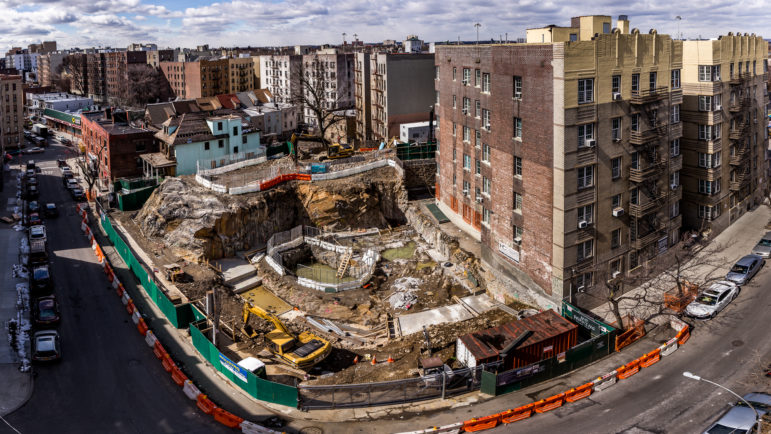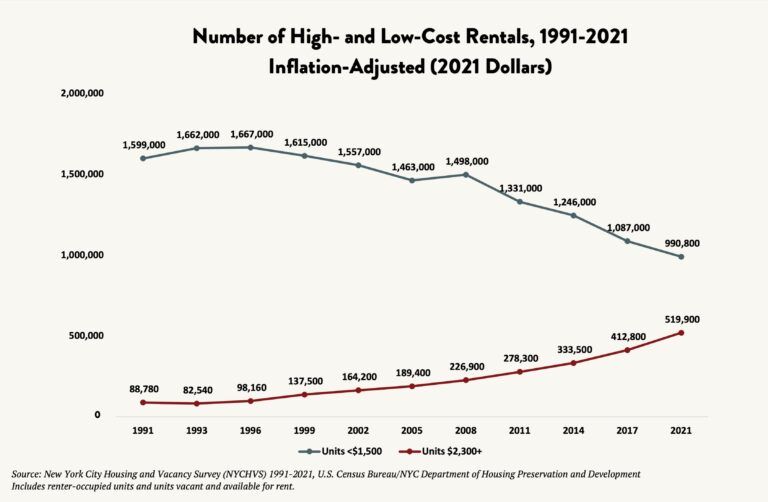Non-profit developers and tenants rights advocates have also been sounding the alarm on the need to create more income-restricted apartments across the five boroughs and to keep existing renters stably housed, especially in communities of color.

Adi Talwar
An affordable housing development under construction in The Bronx.,000 units of affordable housing.
Two curved lines on a graph tell the story of New York City’s affordable housing crisis.
A plunging arc depicts the decreasing number of units priced below $1,500 per month in 2021 dollars over the past three decades: There were 1.6 million of those units in 1991 compared to fewer than 1 million last year. Another line, meanwhile, shows a spike in units renting for more than $2,300 a month over that period—from fewer than 90,000 apartments in 1991 to more than 500,000 last year.
The two contrasting arcs appear in a chart from the recently released Housing and Vacancy Survey, a report compiled every few years to determine whether New York City’s rent-stabilization rules will remain in place (the law says a rate below 5 percent constitutes a “housing emergency”; the rate last year was 4.5 percent).
A policy brief published Wednesday by the Coalition for the Homeless called the trend “an unsustainable trajectory,” fueling a rise in the city’s unhoused population over the same period.

Coalition for the Homeless
Non-profit developers and tenants rights advocates have also been sounding the alarm on the need to create more income-restricted apartments across the five boroughs and to keep existing renters stably housed, especially in communities of color.
The Association for Neighborhood & Housing Development. (ANHD) recently released their 2022 Housing Risk Chart: How is Affordable Housing Threatened in Your Neighborhood?, which details the various threats to housing stability in New York City’s 59 community districts.
The results show “a very high correlation between the percentage of people of color who live in a community district and other threats to housing stability and affordability,” said ANHD policy analyst Lucy Block, the report’s author, during an appearance Sunday on WBAI’s City Watch.
The indicators, Block added, include “eviction filings, overcrowding, rent burden, poor housing conditions, and simultaneously indicators of gentrification and displacement pressure and exclusion from wealth building opportunities like home ownership.”
The ANHD report outlines 19 risk factors, from the number of eviction filings and percentage of overcrowding to the rates of COVID deaths and uninsured residents. Seven of the 10 community districts with the highest number of risk factors are located in The Bronx, the analysis found. The borough also includes eight of the 10 districts with the highest rates of eviction filings.
“We know it in the Bronx because we see it every day,” Fitzroy Christian, a member organizer at the group Community Action for Safe Apartments, told City Watch. “The economic recovery rate in The Bronx, the Southwest Bronx, has not been realized… These are people who can’t afford to pay rent.”
Roughly 2.6 percent of Bronx households are facing eviction, according to county-level tracker published by the state court system. That percentage leads the state and nearly doubles the county, Albany, with the second-highest rate. The Bronx typically accounts for the highest rate of eviction filings in the state, with the percentage of households at risk of losing their apartments surpassing 13 percent in 2019.
Residents are running out of housing options if they lose their current apartments, Christian said. ANHD and CASA, an affiliate of the Mount Eden-based housing and community development organization, New Settlement, are pushing for the City Council to fund the Housing Preservation Initiative (HPI) with $4.36 million. The program allows local groups to notify renters of their rights, work with landlords and intervene on behalf of tenants at risk of eviction and small property owners facing foreclosure.
They have also urged the Council to increase funding for Community Consultant Contracts (CCC), which help fund 46 community-based groups, including CASA, in 41 Council Districts to organize tenants and provide anti-displacement services, like counseling.
The two programs fall under the Community Housing Preservation Strategies Initiative (CHPSI) and “allow groups on the ground to quickly respond to the kind of locally specific conditions shown in the risk chart,” Block said.
The funding boost, she added, will “ensure every Council district has these targeted support services to respond to local threats to housing stability and affordability.”
The episode also featured an interview with journalist Christina Carrega, national criminal justice reporter for Capital B News, who has been reporting from Buffalo following this month’s racist mass shooting. And election attorney Jerry Goldfeder made sense of New York’s redistricting chaos.








One thought on “City Watch: Reckoning With New York City’s Affordable Housing Crunch”
A vital means to building a favorable partnership with your child is through caring touch as well as physical affection. You can’t hold a baby way too much. Holding a baby near you is good for your child and also helps you. We all require the close, caring contact of another human being. Visit now